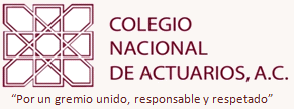
 This month, we have the pleasure of interviewing Carlos Fernando Lozano Nathal, president of the Mexican Colegio Nacional de Actuarios. Carlos holds an undergraduate degree in actuarial science and a master's in business administration from the Universidad Nacional Autónoma de México (UNAM), and is the founder and general director of Nathal Actuarial Consultants, a multinational consulting firm. He is a Fellow of the U.S. Conference of Consulting Actuaries, a professor of actuarial science at UNAM, and was previously an advisor to COPARMEX on Social Security issues.
This month, we have the pleasure of interviewing Carlos Fernando Lozano Nathal, president of the Mexican Colegio Nacional de Actuarios. Carlos holds an undergraduate degree in actuarial science and a master's in business administration from the Universidad Nacional Autónoma de México (UNAM), and is the founder and general director of Nathal Actuarial Consultants, a multinational consulting firm. He is a Fellow of the U.S. Conference of Consulting Actuaries, a professor of actuarial science at UNAM, and was previously an advisor to COPARMEX on Social Security issues.
ACTEX Learning (AL): How many practicing actuaries do you have in Mexico?
Carlos Lozano Nathal (CLN): There are 550 qualified actuaries in the Colegio Nacional de Actuarios (CONAC). There are many more practicing actuaries that are not registered with the CONAC or that work in nontraditional areas.
AL: What is the word for actuary in your local language?
CLN: Actuario for a male actuary and Actuaria for a female actuary
AL: When was actuarial science first introduced?
CLN: 1947
AL: What is your favorite part about being an actuary?
CLN: Serving people and pension plan design
AL: What are some of the highlights of the history of the actuarial profession?
CLN: In 1946, some university students were interested in becoming actuaries, and there was a Mexican association of actuaries (the Mexican Institute of Actuaries, which no longer exists), but no a formal program for studying actuarial science, so they and some members of the Mexican Institute of Actuaries decided to ask to Universidad Nacional Autónoma de México (UNAM) about a new professional studies program to be incorporated under the supervision of the Faculty of Sciences. Four students started taking some classes in the offices of insurance companies and in the UNAM. Over time, the actuarial program was modified to adapt to changing times. Today, in the actuarial program at the Faculty of Sciences at UNAM there are 2,000 students, and there are over 20 schools in Mexico teaching actuarial science.
AL: What are some of the main challenges and projects for your association over the next 5-10 years?
CLN: In Mexico, one must complete four years of university studies to become an actuary. The university provides the student with the degree of Actuary; however, our professional association, Colegio Nacional de Actuarios (CONAC), is the only organization that represents actuaries' interests. In this context, challenges in the next 5-10 years consist in increasing the membership, providing more continuing education programs aligned with current needs and promoting more professional certifications.
AL: What developments on the horizon could affect future opportunities in your country?
CLN: In Mexico, the labor market for actuaries is quite diversified. Traditional fields for actuaries in the areas of insurance, pension and social security have been changing to include activities in banking institutions, consulting firms and private companies. Because of this, the essence of the actuarial profession could be redefined.
AL: What have you seen from inside your company? Where do you think the changes to actuarial work in your country will happen in the next five years?
CLN: In my company I see concern regarding actuaries' continuing education. We understand that future competition will encompass talent, knowledge, practice and service; we are working on improving in these areas. In the near future (5 years), we foresee a movement to participate in companies´ governance, providing models of different phenomena to the corresponding policy committees.
AL: Who are the main employers of actuaries?
CLN: National Institute of Geography (INEGI)
Insurance companies
Banks and financial groups
Consulting firms
National Commission of Insurance and Finance
National Bank of Mexico
Government Offices (e.g. Ministry of the Treasury)
AL: What qualifications do you find most important for upcoming actuaries?
CLN: In addition to the university degree of actuary, it will be important to be certified (by the CONAC) in the areas of insurance, pension and risks.
AL: What is the credentialing procedure like for an actuary in your country?
CLN: The first step is to get a degree in actuarial science from a university. Secondly, to obtain professional experience (usually 5 years) in the selected field and finally to pass the exams administered by CONAC.
AL: Do employers support the cost and time of exam preparation?
CLN: Most of the employers reimburse examination fees, but only a few provide working time to study. Material such as textbooks and study manuals are not normally covered by employers.
AL: Are there any noteworthy non-traditional actuarial positions?
CLN: There are many actuaries working in non-traditional areas. An approximate breakdown of actuaries' areas of practice by percentages is as follows:
Area of Practice - Percentage
Insurance - 23.13%
Finance - 16.43%
Statistics - 14.43%
Pensions - 13.16%
Risk Management - 10.75%
Systems/IT - 10.72%
Planning - 3.69%
Demography - 3.28%
Logistics - 1.84%
Human Resources - 1.30%
Social Security - 1.10%
Other - 1.17%

